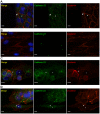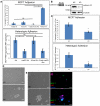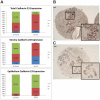Cadherin-23 mediates heterotypic cell-cell adhesion between breast cancer epithelial cells and fibroblasts
- PMID: 22413011
- PMCID: PMC3296689
- DOI: 10.1371/journal.pone.0033289
Cadherin-23 mediates heterotypic cell-cell adhesion between breast cancer epithelial cells and fibroblasts
Abstract
In the early stages of breast cancer metastasis, epithelial cells penetrate the basement membrane and invade the surrounding stroma, where they encounter fibroblasts. Paracrine signaling between fibroblasts and epithelial tumor cells contributes to the metastatic cascade, but little is known about the role of adhesive contacts between these two cell types in metastasis. Here we show that MCF-7 breast cancer epithelial cells and normal breast fibroblasts form heterotypic adhesions when grown together in co-culture, as evidenced by adhesion assays. PCR and immunoblotting show that both cell types express multiple members of the cadherin superfamily, including the atypical cadherin, cadherin-23, when grown in isolation and in co-culture. Immunocytochemistry experiments show that cadherin-23 localizes to homotypic adhesions between MCF-7 cells and also to heterotypic adhesions between the epithelial cells and fibroblasts, and antibody inhibition and RNAi experiments show that cadherin-23 plays a role in mediating these adhesive interactions. Finally, we show that cadherin-23 is upregulated in breast cancer tissue samples, and we hypothesize that heterotypic adhesions mediated by this atypical cadherin may play a role in the early stages of metastasis.
Conflict of interest statement
Figures




References
Publication types
MeSH terms
Substances
LinkOut - more resources
Full Text Sources
Other Literature Sources
Medical

